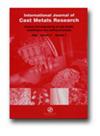Measurement and simulation of residual stresses in grey cast iron as a function of shake-out temperature
IF 1.1
4区 材料科学
Q3 METALLURGY & METALLURGICAL ENGINEERING
International Journal of Cast Metals Research
Pub Date : 2020-05-03
DOI:10.1080/13640461.2020.1766279
引用次数: 2
Abstract
ABSTRACT A high shake-out temperature after casting is beneficial from a production point of view due to the need of a shorter cooling line in the foundry. However, a higher shake-out temperature might also lead to increased residual stresses due to faster cooling. In order to get a good agreement between simulated and measured temperature curves it is important to adjust material data and heat transfer coefficients accordingly. A reduction of the thermal conductivity of the sand by 25% and a drastically increased HTC were the main adjustments. From the residual stress simulation, the most important lesson learned was the necessity to include the sand in the calculation. Especially internal sand cores can greatly restrict the thermal contraction of the casting. After this fine-tuning of the simulation a good agreement with measurements was obtained. It could be verified that an increased shake-out temperature will lead to significantly increased residual stresses.灰口铸铁残余应力随出砂温度变化的测量与模拟
从生产的角度来看,铸造后的高脱砂温度是有益的,因为铸造过程中需要较短的冷却线。然而,较高的脱砂温度也可能由于更快的冷却而导致残余应力增加。为了使模拟温度曲线与实测温度曲线吻合较好,对材料数据和传热系数进行相应的调整是很重要的。主要的调整是将沙子的导热系数降低了25%,并大幅增加了HTC。从残余应力模拟中得到的最重要的教训是必须将砂土纳入计算。特别是内部砂芯可以极大地限制铸件的热收缩。经过对仿真的微调,得到了与实测结果较好的吻合。可以证实,提高脱砂温度将导致残余应力显著增加。
本文章由计算机程序翻译,如有差异,请以英文原文为准。
求助全文
约1分钟内获得全文
求助全文
来源期刊
CiteScore
2.70
自引率
7.10%
发文量
14
审稿时长
7.5 months
期刊介绍:
The International Journal of Cast Metals Research is devoted to the dissemination of peer reviewed information on the science and engineering of cast metals, solidification and casting processes. Assured production of high integrity castings requires an integrated approach that optimises casting, mould and gating design; mould materials and binders; alloy composition and microstructure; metal melting, modification and handling; dimensional control; and finishing and post-treatment of the casting. The Journal reports advances in both the fundamental science and materials and production engineering contributing to the successful manufacture of fit for purpose castings.

 求助内容:
求助内容: 应助结果提醒方式:
应助结果提醒方式:


